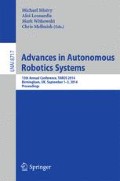Abstract
If robots are to be trusted, especially when interacting with humans, then they will need to be more than just safe. This paper explores the potential of robots capable of modelling and therefore predicting the consequences of both their own actions, and the actions of other dynamic actors in their environment. We show that with the addition of an ‘ethical’ action selection mechanism a robot can sometimes choose actions that compromise its own safety in order to prevent a second robot from coming to harm. An implementation with e-puck mobile robots provides a proof of principle by showing that a simple robot can, in real time, model and act upon the consequences of both its own and another robot’s actions. We argue that this work moves us towards robots that are ethical, as well as safe.
Access this chapter
Tax calculation will be finalised at checkout
Purchases are for personal use only
Preview
Unable to display preview. Download preview PDF.
References
Asimov, I.: I, ROBOT. Gnome Press (1950)
Bongard, J., Zykov, V., Lipson, H.: Resilient machines through continuous self-modeling. Science 314(5802), 1118–1121 (2006)
Braitenberg, V.: Vehicles: Experiments in synthetic psychology. MIT Press (1984)
Holland, J.: Complex Adaptive Systems. Daedalus (1992)
Holland, O. (ed.): Machine Consciousness. Imprint Academic (2003)
Isidori, A., Marconi, L., Serrani, A.: Fundamentals of internal-model-based control theory. In: Robust Autonomous Guidance. Advances in Industrial Control, pp. 1–58. Springer, London (2003)
Liu, W., Winfield, A.F.T.: Open-hardware e-puck Linux extension board for experimental swarm robotics research. Microprocessors and Microsystems 35(1) (2011)
Marques, H., Holland, O.: Architectures for functional imagination. Neurocomputing 72(4-6), 743–759 (2009)
Michel, O.: Webots: Professional mobile robot simulation. International Journal of Advanced Robotic Systems 1(1), 39–42 (2004)
Mondada, F., Bonani, M., Raemy, X., Pugh, J., Cianci, C., Klaptocz, A., Magnenat, S., Zufferey, J.C., Floreano, D., Martinoli, A.: The e-puck, a robot designed for education in engineering. In: Proc. 9th Conference on Autonomous Robot Systems and Competitions, pp. 59–65 (2009)
O’Dowd, P.J., Winfield, A.F.T., Studley, M.: The distributed co-evolution of an embodied simulator and controller for swarm robot behaviours. In: Proc. IEEE/RSJ Int. Conf. on Intelligent Robots and Systems (IROS), pp. 4995–5000 (2011)
Stepney, S., Welch, P., Andrews, P. (eds.): CoSMoS 2011: Proc. 2011 Workshop on Complex Systems Modelling and Simulation. Luniver Press (2011)
Vaughan, R.: Massively multi-robot simulation in stage. Swarm Intelligence 2(2-4), 189–208 (2008)
Vaughan, R.T., Gerkey, B.P.: Really reused robot code from the player/stage project. In: Brugali, D. (ed.) Software Engineering for Experimental Robotics, pp. 267–289. Springer (2007)
Vaughan, R.T., Zuluaga, M.: Use your illusion: Sensorimotor self-simulation allows complex agents to plan with incomplete self-knowledge. In: Proc. International Conference on Simulation of Adaptive Behaviour (SAB), pp. 298–309 (2006)
Wallach, W., Allen, C.: Moral Machines: Teaching Robots Right from Wrong. Oxford University Press, Oxford (2009)
Zagal, J.C., Delpiano, J., Ruiz-del Solar, J.: Self-modeling in humanoid soccer robots. Robot. Auton. Syst. 57(8), 819–827 (2009)
Author information
Authors and Affiliations
Editor information
Editors and Affiliations
Rights and permissions
Copyright information
© 2014 Springer International Publishing Switzerland
About this paper
Cite this paper
Winfield, A.F.T., Blum, C., Liu, W. (2014). Towards an Ethical Robot: Internal Models, Consequences and Ethical Action Selection. In: Mistry, M., Leonardis, A., Witkowski, M., Melhuish, C. (eds) Advances in Autonomous Robotics Systems. TAROS 2014. Lecture Notes in Computer Science(), vol 8717. Springer, Cham. https://doi.org/10.1007/978-3-319-10401-0_8
Download citation
DOI: https://doi.org/10.1007/978-3-319-10401-0_8
Publisher Name: Springer, Cham
Print ISBN: 978-3-319-10400-3
Online ISBN: 978-3-319-10401-0
eBook Packages: Computer ScienceComputer Science (R0)

